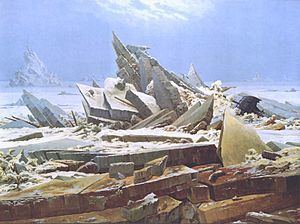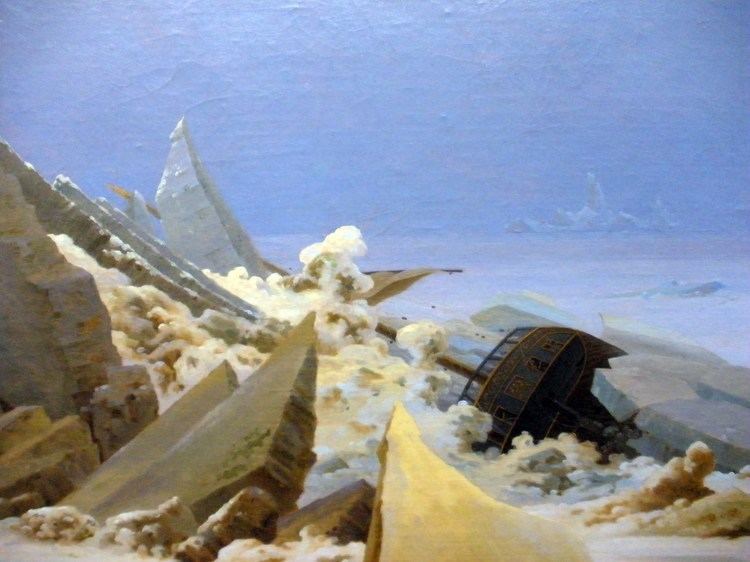Year 1823–1824 Location Kunsthalle Hamburg Media Oil paint | Dimensions 97 cm x 1.27 m Period Romanticism Created 1823–1824 | |
 | ||
Similar Caspar David Friedrich artwork, Artwork at Kunsthalle Hamburg | ||
The Sea of Ice (German: Das Eismeer), also called The Wreck of Hope (German: Die gescheiterte Hoffnung) is an oil painting of 1823–1824 by the German Romantic artist Caspar David Friedrich.
Contents

Description
The landscape depicts a shipwreck in the middle of a broken ice-sheet, whose shards have piled up after the impact. The ice has become like a monolithic tomb, or dolmen, whose edges jut into the sky.

The stern of the wreck is just visible on the right. As an inscription on it confirms, this is HMS Griper, one of two ships that took part in William Edward Parry's 1819–1820 and 1824 expeditions to the North Pole.
Title

The two titles originally referred to the present work and another older work by Friedrich, now missing. The lost painting was shown in 1822 at the Dresden Academy exhibition under the title A Wrecked Ship off the Coast of Greenland in the Moonlight. Own Invention. The present painting was first shown in 1824 at the Prague Academy exhibition under the title An Idealized Scene of an Arctic Sea, with a Wrecked Ship on the Heaped Masses of Ice.
In Friedrich's estate this work was described as Ice Picture. The Disaster-stricken North Pole Expedition.
History
The collector Johann Gottlob von Quandt commissioned two pictures that were to symbolize the south and the north. Johann Martin von Rohden received the commission to paint Southern Nature in her Abundant and Majestic Splendor, while the commission for Northern Nature in the whole of her Terrifying Beauty fell to Friedrich. However, as Schukowski in a letter dated 1821 reported, Friedrich -
himself does not even know what he will paint; he waits for the moment of inspiration, which (in his own words) occasionally comes in a dream.
Accounts of expeditions to the North Pole were occasionally published during those years which is likely how Friedrich became familiar with William Edward Parry's 1819–1820 expedition to find the Northwest Passage. In the winter of 1820–21, Friedrich made extensive oil studies of ice floes on the river Elbe, near Dresden. These were probably incorporated into The Sea of Ice.
The image created a lasting impression on the French sculptor David d'Angers during his visit to Dresden in 1834, which he described as follows:
Friedrich has a somber spirit. He has understood completely how to represent in landscape the great struggles of nature.
Overall, however, the work was seen as too radical in composition, and went unsold until after Friedrich's death in 1840.
From the twentieth century the work has proved extremely influential upon the arctic landscapes of Lawren Harris, and directly influenced Paul Nash's painting Totes Meer. The painting has been hailed by critic Russell Potter as a key instance of the "Arctic Sublime," and an influence on later nineteenth-century polar paintings by Frederic Edwin Church and William Bradford.
The painting is also reproduced on the cover of the Norton Critical Edition (2nd ed.) of Mary Shelley's Frankenstein (1818), and may owe its title to this text:
For some time I sat upon the rock that overlooks the sea of ice... The surface is very uneven, rising like the waves of a troubled sea.
Architect Thom Mayne references The Sea of Ice as a primary influence as to how he approaches the dynamic relationship between architecture, landscape, and nature.
The painting appears on the cover of the album The Mekons: Honky Tonkin' (1987) by UK band the Mekons. It also appears on the cover of the album Return to the Sea (2006) by indie rock band Islands.
